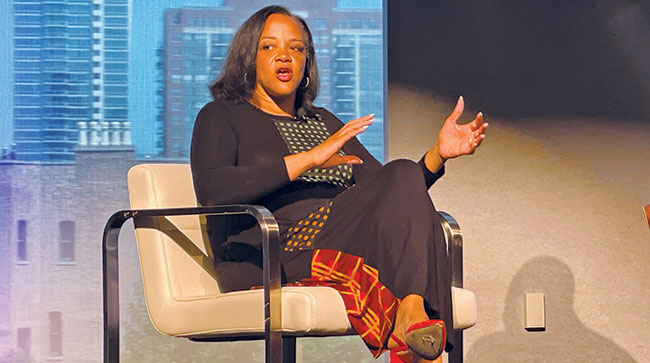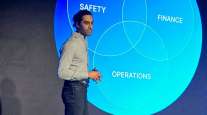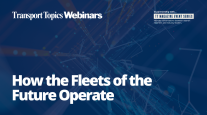Managing Editor, Features and Multimedia
Private Fleets, Shippers Harness Digitization to Improve Operations

[Stay on top of transportation news: Get TTNews in your inbox.]
CHICAGO — The growing adoption of information technology in the transportation industry is creating new opportunities for shippers and private fleets to enhance logistics planning and improve the driver experience.
This trend also is raising questions about how best to use and share the growing amount of data that companies are collecting on their operations, industry executives said at Reuters Events’ Supply Chain Execution USA 2022 conference in June.
The coronavirus pandemic has accelerated this move toward digitization in the logistics space, said Andrea Turner, senior vice president of global customer service and logistics at snack food company Mondelez International, whose brands include Oreo, Ritz and Chips Ahoy.
See the 2022 Top 100 rankings
►Introducing the Top 100 Private Carriers
►Top 100 Private interactive map
►Focus sharpens on driver satisfaction
►Harnessing digitization to improve operations
►Managing change when implementing new tech
Sector Rankings
Food Service | Grocery
Beverage
Petroleum/Chemical
Industrial Gases | Agriculture/Food Processing
Wholesale/Retail | Manufacturing Equipment Rental | Building Materials
Waste Management
Paper/Office Products
Construction
Health Care
Uniform Rental
Media & Entertainment
“There’s never a shortage of data. The question is how to get it and how do you put it together,” Turner said during a panel discussion at the event.
Mondelez International, based in Chicago, ranks No. 46 on the Transport Topics Top 100 list of the largest private carriers in North America.
Apart from utilizing the right data in the right ways, supply chain stakeholders can unlock further efficiency gains by figuring out better ways to share that information, Turner said.
If shippers and their various external suppliers and transportation and warehousing providers can interchange data in a real-time fashion, they can make better decisions, respond more quickly to disruptions and market shifts, and ultimately run their businesses better.
“That’s where we’re headed,” Turner said. “I think everyone has ideas of how to get there. We’re all trying to figure it out … but we’re not there yet.”
Creating this more collaborative supply chain will involve building trust and transparency among multiple organizations with their own separate data feeds, she said.

Turner of Mondelez International says supply chain stakeholders could improve efficiency by agreeing to share more data. (Seth Clevenger/Transport Topics)
“I would love to see those walls come down sooner and quicker, but if you think about all the providers you have, that is a daunting task,” Turner said.
Another challenge for shippers and logistics operations is integrating technology with their workforces.
Artificial intelligence can help improve the accuracy of forecasting, for example, but that’s only half the battle. Companies also must convince staff to trust that information and act upon it.
Turner said technology adoption also plays an important role in employee recruiting and retention, a key topic as many businesses struggle with labor shortages.
![]()
Snack food company Mondelez International operates a large private fleet to deliver products. (Mondelez International)
The next generation expects to work with systems that are connected, efficient and effective, placing the onus on business leaders to keep pace with advances in technology.
“The war for talent right now is so tough,” she said. “People have choices.”
Technology to Support Drivers
In particular, trucking operations are facing stiff competition to recruit and retain professional drivers.
To help strengthen their workforces, private fleets have been taking steps to make those jobs more attractive.
Santa Monica Seafood, for one, has focused on simplifying drivers’ jobs by digitizing and automating their daily tasks.
![]()
Burnout from supply chain disruptions combined with more lucrative opportunities has driven up turnover rates among supply chain managers. (Victor J. Blue/Bloomberg News)
“Making it easy is super important,” James Nissenberg, the company’s vice president of logistics, said at the Reuters conference.
The wholesale seafood distributor uses its private fleet of about 80 vehicles, including box trucks, cargo vans and tractor-trailers, to provide final-mile deliveries of seafood and other highly perishable food products.
Santa Monica Seafood provides its drivers with prepared route plans in logical sequence and has equipped its vehicles with telematics, including temperature and humidity monitoring capabilities that do not require driver interaction.
“They don’t have to touch that,” he said. “We’re getting that information automatically.”
In addition, the company’s drivers conduct their routine vehicle inspections on their phones rather than on paper.
“Now it’s all digital. It’s recorded in a database. It makes their life easier.”
The Omnichannel Evolution
Shippers and retailers also are adjusting their supply chains in response to the expansion of e-commerce, which grew at an even faster pace during the pandemic.
Fashion retailer Macy’s, for example, continues to refine its omnichannel strategy to support consumers’ shifting habits.
“We are focused on meeting the customer where they are at and how they shop,” Dennis Mullahy, chief supply chain officer at Macy’s, said at the Reuters conference.
Want more news? Listen to today's daily briefing above or go here for more info
“Omnichannel isn’t just digital. It’s really about integrating and tying into how customer behavior is changing,” he said. “We have customers that shop in our stores. We have customers that shop online at home. We have customers that shop in our stores, online.”
Physical stores remain a crucial part of Macy’s business, and “always will be,” Mullahy said, but the role of those physical locations is evolving.
“Your store now plays a different role in the ecosystem, because not only does it engage the customers, it’s also holding inventory that can engage with digital customers,” Mullahy said. “If I run out of stock, I need to be able to take it out of the store and move it, and I need to do that seamlessly.”
Meanwhile, the many disruptions of the past couple of years have placed a greater emphasis on supply chain resiliency and flexibility.
“I think we saw how fragile the supply chain was in 2020. And it didn’t just happen — it’s been an ongoing problem. We just haven’t seen as many links in the chain break as what happened literally across the board to everybody in 2020,” Mullahy said. “I think that has opened a lot of eyes to this notion that we can’t just take for granted that you can put product on a boat and it comes over and shows up.”





